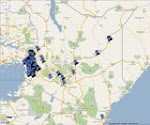Problematic bucket latrine system in Wajir
BY Adan .A. Hassan of ALDEF - Ecological sanitation in North Eastern Province of Kenya (hassan_adan@yahoo.com)
PROBLEMATIC BUCKET LATRINE SYSTEM IN WAJIR TOWN
Location is displayed here - link is coming!!
In Wajir town human waste disposal is undertaken through a bucket latrine system which is managed by the local authority – Wajir County Council. There are approximately 5,000 bucket latrines and they are increasing as the population increases. Most of this bucket latrines are found in Wajir town and surrounding areas. The bucket latrine system was introduced by the colonial government because of the high water table in the area and was to prevent underground water contaminations which was and is the only source of water supply in Wajir.
The main source water supply in water in Wajir town are shallow wells which are not protected from contamination and not covered. How the bucket latrine waste contaminate the shallow wells which are community water sources. The bucket latrine is not collected and disposed frequently, as a result the bucket over flows and there high seepage human waste in the ground which highly contaminate the sources of water also there service contamination since the shallow wells not covered and the water drawing methods. In an individual’s plot of 50 by 100 ft compound both bucket and shallow wells are situated, creating high chances of contamination.
The only alternative solutions to reduce the level of contamination from the bucket latrine are the introduction of an ecological sanitation which has improved to some level. Our future focus is to kick out bucket latrine in Wajir town by promoting ecosan.
 |
| Rear side of a household bucket latrine - often the buckets are not collected and overflow into the open of the compound |
 |
| An open shallow well which is exposed to contamination. Bucket latrines and wells are often placed on the same plot making it prone to contamimation. |


